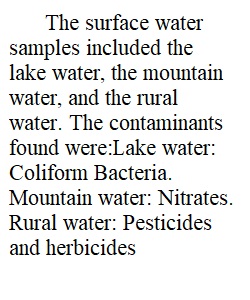


Q 1. What contaminants were found in the surface water samples? What contaminants were found in the ground water samples? 2. Why might surface water and ground water have different contaminants? 3. Generally farmers do not farm, and industries do not build factories on the sides of the mountains in remote wilderness areas. These areas are not usually highly populated by people. What might explain the high nitrate level in the mountain water in this activity? 4. What is pH level? What are its characteristics and how does it contribute to pollution? What chemicals are used in treating low pH levels? 5. Water in an old building, tested recently, showed high iron and copper content, and low pH levels. A water reading taken 20 years before showed low pH levels but only minimal traces of copper and iron. If none of the new buildings on the same street showed signs of metallic contaminants, but all reported lower than normal pH readings, how might these readings be explained?
View Related Questions